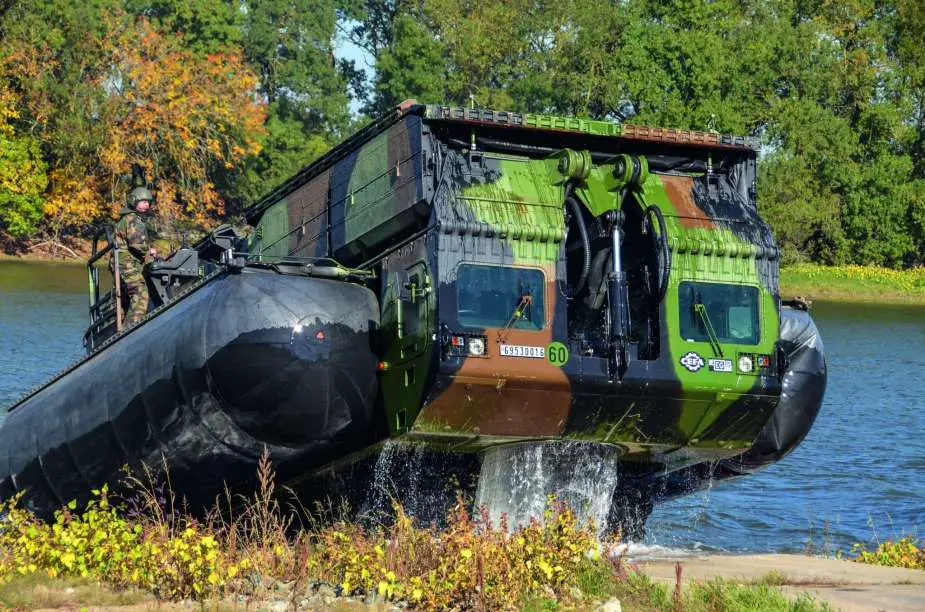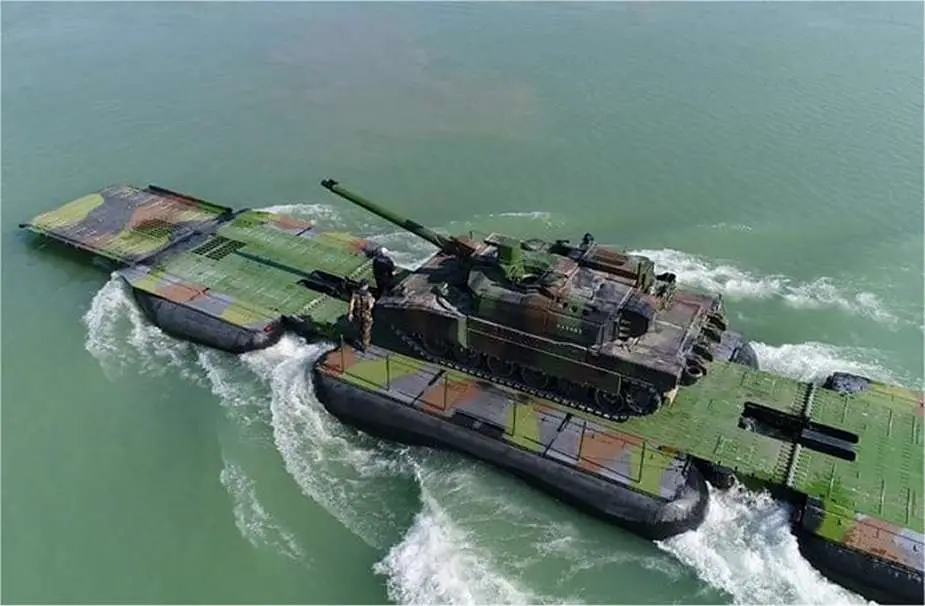- Army
- Conflicts in the world
- Israel - Iran conflict 2025
- Pakistan - India Conflict 2025
- Russia Ukraine War 2022
- Libya conflict day by day
- HAMAS - Israel War 2023
- Operation Serval in Mali French Army
- Sangaris operation Central African Republic
- Sangaris opération militaire République Centreafrique
- Ukraine - Russia conflict
- Syria conflict news
- Defence & Security Industry Technology
- Armies in the world
- Analysis Defense and Security Industry
- Conflicts in the world
- Navy
- Air
French company CEFA to supply Ukraine with 8 EFA pontoon bridges
As reported by Ouest France on September 30, 2023, the French company CEFA (Conception et Études de Fabrication d'Armements) is set to supply Ukraine with 8 EFAs (Engin de Franchissement de l’Avant - Frontal Breaching Engine) self-propelled pontoon bridges and 8 SDZ mine clearance vehicles. These systems, sourced from the former engineer park, will be soon delivered. Ukraine has previously received a range of AVLB (armored vehicle-launched bridge) vehicles, including 34 Biber vehicles (29 from Germany and 5 from the Netherlands), 2 M-3 Bridge and Ferry systems from the Netherlands, and 18 M60 AVLB vehicles from the United States.
Follow Army Recognition on Google News at this link

Ukraine will receive a total of 8 EFA self-propelled pontoon bridges, which also can act as an armored vehicle-launched bridge (Picture source: CEFA)
The EFA (Engin de Franchissement de l’Avant or Frontal Breaching Engine) is a self-propelled pontoon bridge engineering vehicle that has been specially designed for tactical breaching in high-intensity combat scenarios. It is a versatile amphibious bridging and ferrying system with capabilities that are tailored to address the critical need for swiftly overcoming obstacles during military operations without impeding the ongoing maneuver.
The EFA offers various operation configurations, including ferry mode, raft mode, pontoon bridge mode, bridge mode, and dry-gap crossing. It can carry heavy tanks, light tanks, or infantry combat vehicles, providing flexibility in military operations. Its ability to be ready for use within a few minutes, transitioning from road to river, is a critical advantage in rapidly changing combat situations.
One of the standout features of the EFA is its capacity to handle heavy loads. It falls under Military Load Classification (MLC) 70, meaning it can support loads of up to 70 tons. This capability allows it to accommodate a heavy tank, two light tanks, or multiple infantry combat vehicles, making it an invaluable asset in military logistics and bridging operations.
The autonomous nature of the EFA is another factor that enhances its efficiency. It requires only a two-person crew for implementation, eliminating the need for additional equipment or vehicles.
Furthermore, the EFA, in its UAE version, has proven its superior performance under extreme climate conditions, making it a reliable choice for military operations in a variety of environments.
In its land configuration, the EFA can handle transversal slopes of up to 30% thanks to its adjustable hydraulic suspension on two axles. The vehicle can also adjust tire pressure while driving, achieving speeds of up to 80 km/h on roads, a road range of approximately 700 km, and it has a 50% climbing capability. The EFA is also suitable for dry-gap crossing with a maximum gap of 12 meters and a payload capacity of 70 tons.
When it comes to water operations, the EFA offers multiple configurations, including ferry mode and raft mode, accommodating various types of loads, including heavy tanks, medium tanks, or infantry combat vehicles. A minimum crew of 2 soldiers is required for its operation in water. In ferry mode, an EFA has a carrying capacity of up to 70 tons.

One single EFA self-propelled pontoon bridge is able to carry heavy tanks, such as the French Leclerc MBT, up to 70 tons (Picture source: CEFA)
The EFA can also be used in raft mode, allowing for multi-bay ferry operations. Two EFAs, when used together, can transport a load classified as MLC 150. For instance, they can carry 1 AUF-1 GCT self-propelled howitzer and 2 light tanks.
In addition to ferry and raft modes, the EFA can be employed in pontoon bridge mode, where multiple EFAs can be combined for river crossing operations. For instance, creating a 100-meter pontoon bridge requires 4 EFAs and can be accomplished in approximately 15 minutes with a maximum of 8 soldiers.
The EFA has a range on water of 8 hours, with water speeds of 3.8 m/s when unloaded and 3.1 m/s when loaded. It can reach a height of bank with a ramp at 30% of 3.3m when empty and 3.7m when loaded,
Preparing the EFA for water operations is a swift process. Floats can be inflated in just a few minutes, and ramps can be deployed in as little as 30 seconds. The vehicle can navigate a slope of up to 50% on all types of riverbanks, enhancing its adaptability in aquatic environments.
The technical specifications of the EFA highlight its robust design and capabilities. It features a 4-wheel drive and 4-wheel steering system, a 6-speed automatic gearbox, a tire-pressure adjusting system, retractable axles, differential and adjusting locks, and an automatic fire extinguishing system. The EFA is powered by a 560 kW MTU Diesel engine and is equipped with two 360° turnable hydrojets, each delivering 210 kW of power for aquatic propulsion. Its usable roadway width is 4 meters, and it offers customized equipment options, including NBC (Nuclear, Biological, Chemical) protection, air conditioning, and an intercom radio system.
In terms of dimensions, the EFA is a substantial vehicle. When its bridges are retracted, it has a width of 3,6 m, a height of 4,1 m, and a length of 12,6 m. When the bridge is erected, the length extends to 23,7 m, and the width increases to 4 m. In ferry mode, the EFA measures 34,5 m in length and 7 m in width.

When its bridges are retracted, the EFA self-propelled pontoon bridge has a width of 3,6 m, a height of 4,1 m, and a length of 12,6 m. (Picture source: CEFA)


























